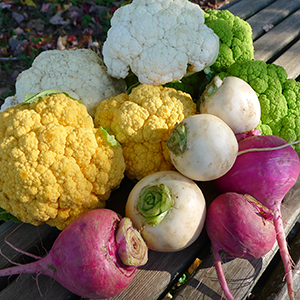
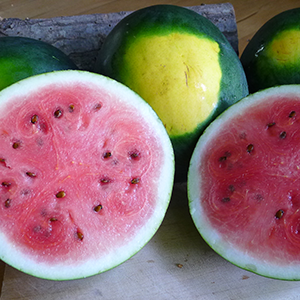
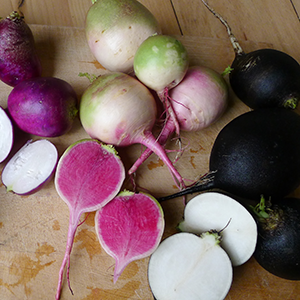

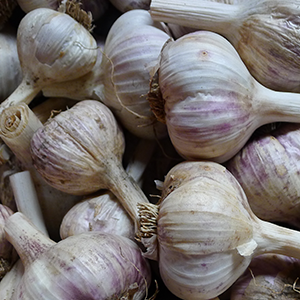
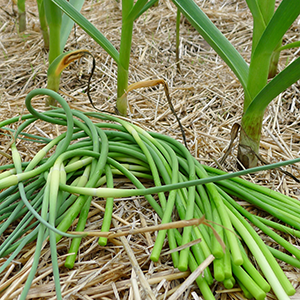
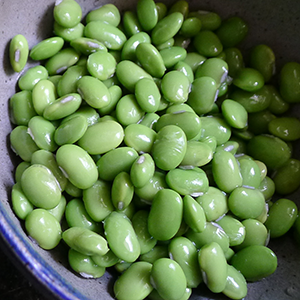



News and Notes | The Anchor Run Blog
Posts Filtered by Month - October 2016 |
Show Recent Posts
October 30, 2016
Workshifts For Week of 10/30
By Derek McGeehan
Workshifts For Week of 10/30
By Derek McGeehan
Wow, so now that we're almost in November there are only a few more farm tasks that we'll need some help with. If you're not planning to work this season, please remit the balance of your share cost soon (shares are discounted when you help us on the farm). Half shares work 4 hours, full shares work 8 hours, over the course of the entire season. To "buy-out" of your work hours at $15/hour, please send a check payable to "Anchor Run CSA" at 2578 2nd Street Pike, Wrightstown, PA 18940. Please don't feel guilty about this option!
As of now no workshifts are scheduled for this week.
Workshift sign-up instructions may be found here.
Thank you!

October 30, 2016
Sign Up for Extended Seasons - Saturday Pick Up Added
By Derek McGeehan
Sign Up for Extended Seasons - Saturday Pick Up Added
By Derek McGeehan
It's time to sign up for our 5th annual Late Fall CSA as well as our inaugural Winter CSA to receive your supply of fresh, local, and organic produce through the dark winter months!
Enrollment in these seasons is limited and will be filled on a first-come first-serve basis. Current Main Season CSA shareholders will be given priority until November 1, 2016, when the general public will be able to enroll. We want to fill these CSA seasons with our current members but need to reach a critical mass for these seasons to run successfully.
To participate in these seasons, please Log in to the website and click the green 'Join' buttons on the left hand side of your member page.
2016 Late Fall CSA:
- 6 weeks of fresh and storage crops from weeks 11/13/16 through 12/18/16
- weekly full shares ($180) and biweekly half shares ($100) available
- share distribution on Wednesdays 1-8pm (except for Tuesday 11/22/16) and Saturdays 11am-12noon
- should include a variety of crops like beets, potatoes, radishes, turnips, sweet potatoes, leeks, garlic, scallions, lettuce, radicchio, cabbage, napa cabbage, arugula, mizuna, mustard greens, kale, collards, chard, spinach, herbs, etc.
2017 Winter CSA:
- 8 weeks of fresh and storage crops from weeks 1/1/17 through 2/19/17
- weekly full shares ($240) and biweekly half shares ($130) available
- share distribution on Wednesdays 1-8pm and Saturdays 11am-12noon
- should include a variety of crops like beets, potatoes, radishes, turnips, sweet potatoes, leeks, garlic, scallions, lettuce, cabbage, napa cabbage, arugula, mizuna, mustard greens, kale, collards, chard, spinach, herbs, etc.
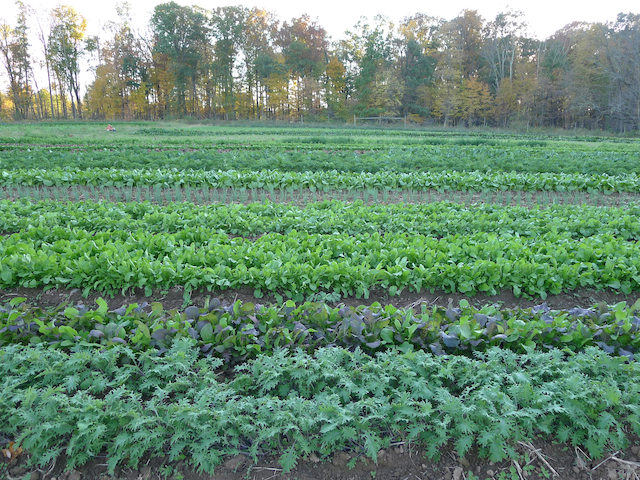
An uplifting mix of vegetable crops will nourish us through the cold months!

October 30, 2016
Frost Tolerant Vegetables
By Derek McGeehan
Frost Tolerant Vegetables
By Derek McGeehan
Main Season CSA Harvest #25 (Week A) should include sweet potatoes, kale, leeks, lettuce, arugula, greens mix, spinach, bok choy, endive, escarole, chard, potatoes, napa cabbage, cilantro, dill, and miscellaneous roots. Some items will be a choice and may not be available during all pick up times. U-pick should include cilantro, dill, and parsley. The perennial herb gardens needs to rest for the winter.
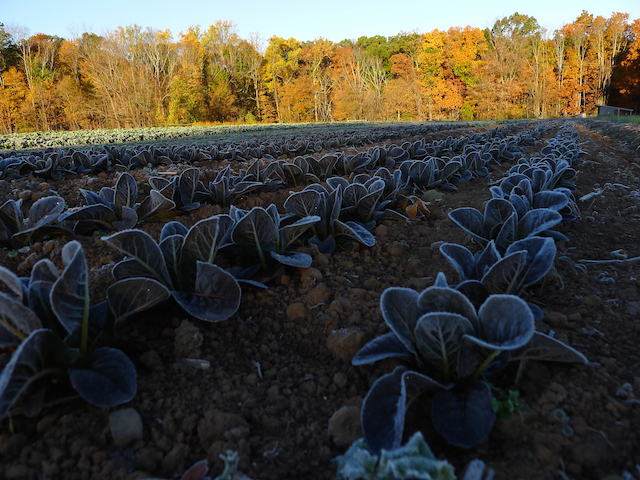
Like most of what is grown outside on the farm this time of year, these "breen" mini-lettuces tolerate the first few rounds of heavy frost. Lows on Wednesday and Saturday mornings bottomed out at 29-30 degrees; when they drop farther into the 20s is when we need to begin covering some crops with floating row cover, or accept damage.

October 30, 2016
Frosty Mornings and Another Round of Summer
By Derek McGeehan
Frosty Mornings and Another Round of Summer
By Derek McGeehan
We sustained our first widespread heavy frost this week and all of the crops made it through unscathed and hopefully sweeter. The fact that we're almost into November and haven't experienced a damaging low in the 20s is soothing, but it will come soon enough. Putting out mini-hoops and floating row cover is a task that is easily put off until absolutely necessary. Forecasted temporary dips in temperature always seem to be preceded by a very windy day which renders floating row covers into large unmanageable kites. This is one main reason we're fully embracing growing in all of our larger plastic covered structures this fall and winter. The hoop house, high tunnel, and greenhouse will protect much of our fresh crops during the Late Fall CSA and Winter CSA seasons. The size of these structures makes harvesting easier and the thick plastic gives plants an additional 5-10 degree buffer. We can also add another layer of hoops and row cover on the inside that adds further insulation. Crops are also protected from wind, rain, and snow. Because the greenhouse has an inflatable layer of plastic and the option of supplemental heat, we can grow certain crops in there that aren't quite as cold tolerant as others. Crops like beet greens, chard, and lettuce aren't quite as cold hardy as kale, arugula, and spinach. To enjoy the winter delicacies you should join our Late Fall CSA and Winter CSA!
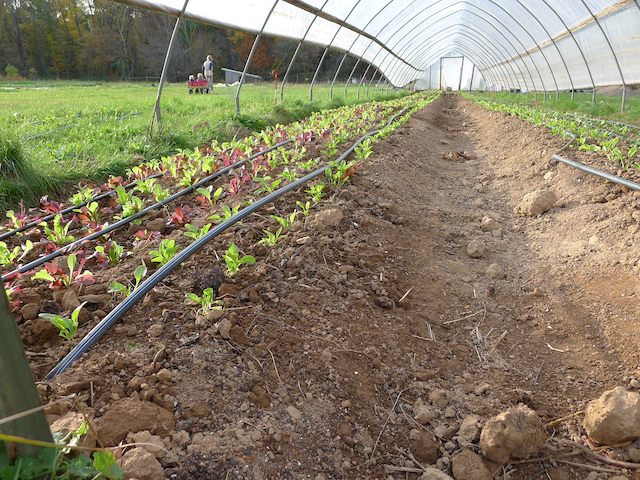
Lettuce mix, chard, spinach, and scallions under protection inside the hoop house.

October 30, 2016
Catching up on harvests
By Linda Dansbury
Catching up on harvests
By Linda Dansbury
Last week I mentioned being away and falling behind on using/enjoying my share so I got busy making soups to freeze for easy meals later in the year. I have found that I am much better at eating my greens if I put them into something rather than just freezing the greens and adding them to a dish later. The good thing about soups is you can add A LOT of greens to them - it is almost impossible to over do it, so I felt really good being able to use everything in healthy, delicious ways. This week I began using my pressure cooker in earnest too. I received it last Christmas and made some things in it but now I am starting to make my own recipes, just using the cookbook as a guide for setting the pressure and cooking times. If you have one, dig it out of your closet! Amazing food is ready in an hour or less! And clean up is easy too.
Leeks, greens(mizuna, cabbage, Swiss chard, spinach), potatoes, carrots, parsley, garlic- made a beef veggie with lots of greens soup. Ate it for a night and froze the rest in meal sized portions.
Onions, cabbage, kale, carrots, potato, garlic - made a traditional Italian soup called Ribollita. It does take some time to make, but it is worth it. I had seen the recipe in the Food section of the Phila Inquirer, but found a version on line that is essentially the same. The version I used topped the dish of soup with a poached egg, making it even more hearty but certainly not necessary.
Onion, cilantro, mint - made Vietnamese Chicken Pho in the pressure cooker thursday night - I was so happy to receive the beautiful cilantro in my pick up!
Onion, garlic - prepared country spare ribs in pressure cooker - meat only needed to cook for 30 minutes and came out fall apart tender. And...there are plenty of leftovers for later in the week.
Spinach, onion, bacon(from Ledemete Grass) - made Spinach Salad with Warm Bacon Dressing. This is such amazing spinach and we are enjoying it tremendously!

October 30, 2016
More soups!
By Linda Dansbury
More soups!
By Linda Dansbury
Fellow member and one of the founders of Anchor Run, Robin Hoy, sent me a recipe that she made this week that sounds delicious - Potato Leek Kale Soup.
Thanks Robin!

October 30, 2016
Ledamete's Turkey and Stocking Up Sale!
Ledamete Grass Farm
Ledamete's Turkey and Stocking Up Sale!
Ledamete Grass Farm
Thanksgiving is quickly approaching and we're sure to sell out! Reserve your turkey today to be sure we have one for you.
We'll have a "Stock Up" Market in conjunction with our turkey pick up on Nov. 22nd 4-7pm so you can be sure to enjoy our pastured chicken, forest & pasture-raised pork, and 100% grassfed beef all winter long!
Click here for a full inventory listing and to order. Available for purchase now:
Pasture & Forest-Raised Pork
Pastured Poultry
100% Grassfed Beef
Pasture & Forest-Raised Pork
Pastured Poultry
100% Grassfed Beef
STOCKING UP ORDER DEADLINE- MIDNIGHT ON NOVEMBER 2ND!
Turkey & Stocking Up Market Date: Tuesday, Nov. 22nd from 4-7pm * Pre-orders ONLY!
Want to see what we are up to day to day on the farm? Follow us on Facebook!
Your Farmers,
The Fix Family
5471 Sell Rd.
Schnecksville, PA 18078
ledametegrassfarm.com
farmers@ledametegrassfarm.com
610-767-4984
Your Farmers,
The Fix Family
5471 Sell Rd.
Schnecksville, PA 18078
ledametegrassfarm.com
farmers@ledametegrassfarm.com
610-767-4984

October 30, 2016
Greens, Greens and yes, More Greens
By Linda Dansbury
Greens, Greens and yes, More Greens
By Linda Dansbury
After the many years I have been a member of Anchor Run, I am still learning so much about eating locally and how to best enjoy the harvests.
This week I focused on catching up on my harvests and using greens - which took some time but it was fun making the large pots of soup and filling my freezer with easy meals for dark, cold winter nights.
As I have said many times, greens are interchangeable, so if a recipe calls for kale, but you have chard, that's fine. Add mizuna, endive, escarole to any soup or stew to boost the nutrition, and add color to the pot.
I really love receiving the chicories: endive, escarole, radicchio because they are equally happy in a salad or cooked.
I usually do a mix of greens for salads - in the fall and winter, a mix of endive, escarole, mizuna, leaf lettuce with your favorite vinaigrette is delicious - these heartier, slightly bitter greens are delicious with "add-ins" - they welcome the sweetness of thinly sliced local apples or pears, dried cranberries, pomegranate arils, and nuts such as almonds and pecans. A crumble of feta or blue cheese on these salads is also delicious - with a salad that is this large and loaded with flavor, I often just have this with a simply prepared piece of meat.
Enjoy your greens!
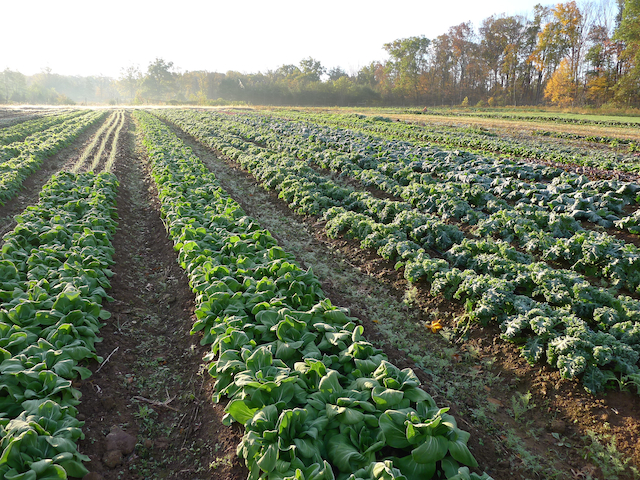
Frosted greens slowly warming up in the morning sunshine.

October 23, 2016
Sign Up For 2016 Late Fall and 2017 Winter CSAs
By Derek McGeehan
Sign Up For 2016 Late Fall and 2017 Winter CSAs
By Derek McGeehan
It's time to sign up for our 5th annual Late Fall CSA as well as our inaugural Winter CSA to receive your supply of local and organic produce through the dark winter months!
Enrollment in these seasons is limited and will be filled on a first-come first-serve basis. Current Main Season CSA shareholders will be given priority until November 1, 2016, when the general public will be able to enroll. We want to fill these CSA seasons with our current members but need to reach a critical mass for these seasons to run successfully.
Also, we're currently re-evaluating the best pick up day/time for Fall and Winter seasons, so please let us know if our proposed schedule does not work for you. See below for details!
To participate in these seasons, please Log in to the website and click the green 'Join' buttons on the left hand side of your member page.
We're currently filling up our protective hoop house, high tunnel, and greenhouse with lettuce mix, arugula, kale, spinach, scallions, chard, mizuna, and mustard mix to ensure a steady supply of fresh greens through the winter! Beat the cold and flu season by eating the nutritionally beneficial crops that we grow!
2016 Late Fall CSA:
- 6 weeks of fresh and storage crops from weeks 11/13/16 through 12/18/16
- weekly full shares ($180) and biweekly half shares ($100) available
- share distribution on Wednesdays 1-8pm (except for Tuesday 11/22/16)
- should include a variety of crops like beets, potatoes, radishes, turnips, sweet potatoes, leeks, garlic, scallions, lettuce, radicchio, cabbage, napa cabbage, arugula, mizuna, mustard greens, kale, collards, chard, spinach, herbs, etc.
2017 Winter CSA:
- 8 weeks of fresh and storage crops from weeks 1/1/17 through 2/19/17
- weekly full shares ($240) and biweekly half shares ($130) available
- share distribution on Wednesdays 1-8pm
- should include a variety of crops like beets, potatoes, radishes, turnips, sweet potatoes, leeks, garlic, scallions, lettuce, cabbage, napa cabbage, arugula, mizuna, mustard greens, kale, collards, chard, spinach, herbs, etc.
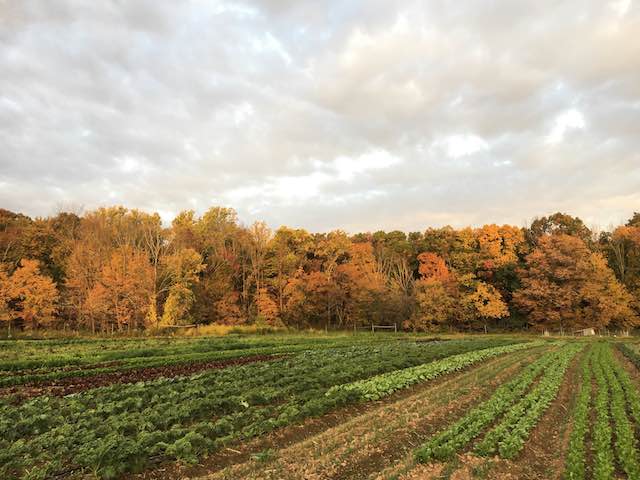
A Bucks County farm scene - courtesy of Mary Liz - with late-fall kale, collards, scallions, arugula, radishes, lettuces, and mustard mix accentuating the mid-fall golden deciduous leaves.

October 23, 2016
Greens and Roots
By Derek McGeehan
Greens and Roots
By Derek McGeehan
Harvest #24 (Week B) should include sweet potatoes, leeks, chinese/napa cabbage, lettuce, kale, endive, chard, escarole, dill, cilantro, chives, kohlrabi, turnips, celeriac, beets, cauliflower, broccoli, greens mix, spinach, mizuna, and arugula. Some items will be a choice and/or may not be available during all pick up times. U-pick should include cilantro, dill, parsley, and perennial herbs.
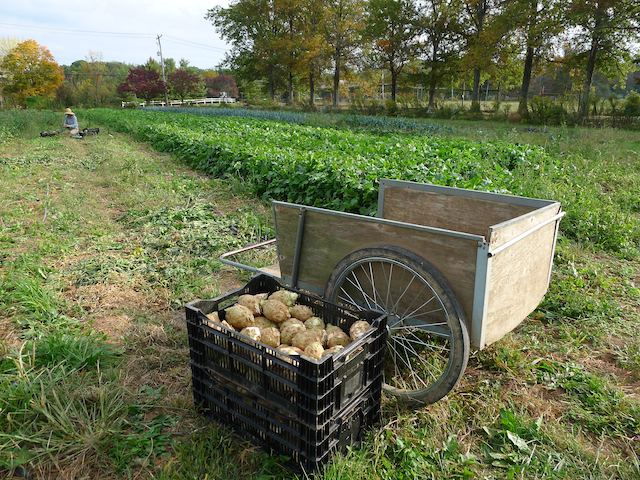
A fine gnarled fall and winter root, celeriac aka celery root, provides nourishment and awesome celery flavor throughout the cold months via roasts and soups.

October 23, 2016
Three More Weeks of Main Season CSA
By Derek McGeehan
Three More Weeks of Main Season CSA
By Derek McGeehan
The brief return to summer-like weather is over, thankfully, and some much needed rain fell as the cold front made its way through the area. We irrigated some thirsty crops earlier in the week and would have had to add water to other crops had the rain missed us. We transplanted lettuce mix, spinach, scallions, and chard into the hoop house for December harvest and direct seeded arugula, kale, mizuna, and mustard mix into the high tunnel for January and February harvest. We sowed winter rye and hairy vetch cover crop into the heirloom tomato, cherry tomato, sweet potato, and field tomato areas; this was probably the final cover crop sowing of the season. We have one more outside crop to plant - garlic - sometime over the next few weeks and will direct seed another round of greens in the high tunnel within a week or two. We're preparing the greenhouse for mid-winter growing where we can control the temperature with supplemental heat, if needed. Last week we also finished harvesting celeriac and kohlrabi for distribution over the next few months. Thanks to the wonderful CoolBot, our cold storage area is almost double what it was last winter. And this coming week we'll have the pleasure of dealing with the first potentially heavy frost of the fall as lows are forecast to drop into the low 30s, wich probably means upper 20s here.
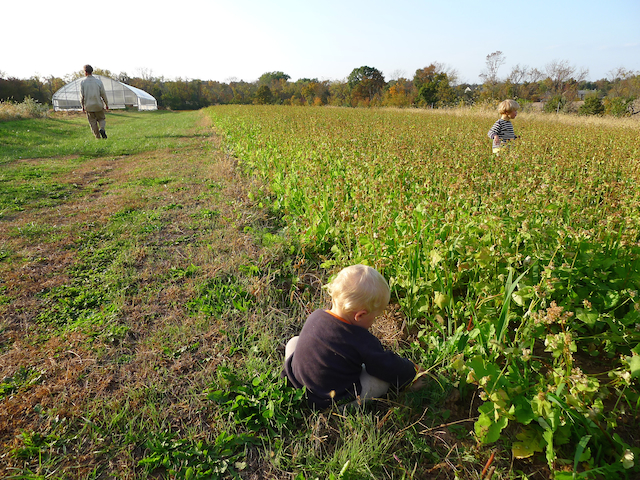
A warm summer day in fall beckons the kids to trundle through the daikon, buckwheat, and oat cover crop.

October 23, 2016
The sweets, and other things are here!
By Linda Dansbury
The sweets, and other things are here!
By Linda Dansbury
Sweet potatoes are here! Proper storage is important for keeping sweets for any period of time. Sweet potatoes should never be stored in the fridge - the low temps cause cellular changes which effects both cooking and taste of the potatoes. They prefer to be stored at a temp range of 55-60 degrees, which is difficult to maintain. If you have a basement or garage, they are probably the best bet, although when temps really start to drop they will need to be moved inside from the garage. They also like it dark, so if you want to try and store them for any real length of time, wrap them individually in newspaper and then place in a bag or box. I have read that placing an apple in the box/bag keeps the potatoes from sprouting, but I have never tried this myself. Do not try to store the potatoes with bad bruises or open cuts - cook those immediately.
Sweets are delicious roasted - I love to do a mixed roast of the various items we receive this time of year: potatoes, leeks, sweets, celeriac, turnips, winter squash, kohlrabi. They also are delicious boiled and mashed, either alone or in combination with potatoes and celeriac.
Celeriac is a little known and under appreciated veggie, maybe because it looks a little intimidating. It is delicious both raw and cooked. They are able to store for long periods of time in plastic in the fridge. The main thing is to be careful when peeling them (however Derek and Dana don't peel them). Cut a bit off each end and then sit it on the cutting board and with a sharp knife slice/peel down the sides, trying not to take much of the flesh. Then slice or chopped as desired. There are several recipes on this site, including Celeriac Remoulade and Celeriac and Potato/Leek Puree.
Napa cabbage - We have been receiving different cabbages over the past several weeks - have you wondered what the differences are and if they are interchangeable? The "regular" green/red, round cabbage with the smooth leaves is the strongest tasting and takes the longest to cook to get to be tender, if you are going that route vs using in a slaw. The next one is savoy, which is also round, but with pretty, crinkled leaves. It is less strong and cooks a bit faster than green/red cabbage. Napa is the mildest and fastest cooking of the 3 and is the choice for stir fries and other Asian dishes. They all store very well when in plastic in the fridge.

October 23, 2016
Amazing Fall Crops
By Linda Dansbury
Amazing Fall Crops
By Linda Dansbury
I was out of town, so haven't written this column in awhile and am having trouble remembering all that I have cooked over the past couple of weeks. Obviously, when you go away, if you maintain your pick ups, you have A LOT to eat when you come back home. Fortunately, much of the harvest at this time of year can either be stored for awhile or is very flexible in its uses. Here are a few things that I have made:
Spinach, parsley, onions, bacon(from Ledamete) - the spinach has been awesome this year - sweet, tender and so delicious! So, I hate to cook it, especially when there has also been chard that is a great spinach substitute in cooked dishes. So, we have been enjoying Spinach Salad.
Butternut squash, leeks, onion, carrot, garlic - made the Indian Roasted Pumpkin Soup with squash that had a couple of bruises. As often happens, I had forgotten about this recipe so doing a search every couple weeks helps me come up with wonderful ways to use the harvest.
Kale, potatoes, onions - there is a really simple 1 dish meal I make for a yummy week night meal. Remove thick stems from kale and roughly chop. Cut up potatoes into bite sized pieces and thinly slice onions. Combine them in the baking dish you will use and drizle olive oil and add salt and pepper to taste - I like to add some thyme or other herb as well. Mix well and even out in baking dish. On top of bed of veggies, place chicken legs and thighs, sprinkly with salt and pepper and paprika. Cover with foil and bake at 375 for about 20 minutes. Remove foil and continue baking until chicken is cooked through and the skin is nice and browned.
Greens, onion, leeks, garlic, hot pepper, ginger, herbs, canned beans - week nights are hectic for many of us. Sauteing or stir frying greens with a couple of the "add-ons" makes getting a deliicous healthy side dish to the table really simple. Start with the onion, leeks and/or garlic/hot pepper in a bit of olive oil. When cooked to desired tenderness(don't burn the garlic), add the greens - they will cook down dramatically, so use way more than you think you will need. When greens are starting to wilt, add other flavorings such as soy and/or fish sauce, fresh herbs, canned or fresh tomatoes, white beans or chick peas - the only limit is your imagination! Serve with some type of grain and/or meat.
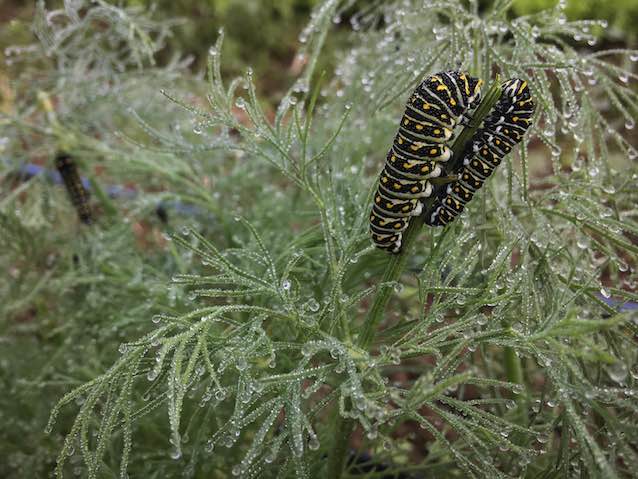
Thanks again to Mary Liz for a great photo. Does it need a caption? These are swallowtail butterfly larvae dining on dew covered dill. It's difficult for us to define these as pests since they're so attractive.

October 16, 2016
Ledamete Grass Farm's Monthly Market October 20, preorder now!
Ledamete Grass Farm
Ledamete Grass Farm's Monthly Market October 20, preorder now!
Ledamete Grass Farm
Ledamete Grass Farm will be at Anchor Run Farm for a market day on Thursday, October 20 from 1-5pm*!
*If you can't make that day/time, pre-orders can be left in the freezer for you to pick up on your next share day (you have 2 weeks to pick it up).
Order Your Pastured Meats Today- Deadline Midnight October 19!
100% Grassfed Beef
Pasture & Forest Raised Pork
Pastured Chicken
100% Grassfed Beef
Pasture & Forest Raised Pork
Pastured Chicken
PRE-ORDERS preferred but day of sales will be welcomed.
To learn more about our farming practices, read below, visit our website, and check us out on Facebook. . To order visit our e-commerce site here.
Ledamete Grass Farm Pasture & Forest-Raised Pork
We raise Tamworth cross heritage breed pigs, as they thrive in the forest and field and are known for their excellent flavor. In addition to forage, our pigs are fed local grain raised with organic methods, organic veggie compost, and grass-fed raw dairy products.
Ledamete Grass Farm Pastured Poultry
Our chickens and turkeys are raised on pasture with constant access to fresh bugs, herbs and grasses. In addition to the forage they find, we provide our birds with grain, grown and milled fresh by a local farmer who utilizes organic methods. The birds' access to fresh air, exercise, sunshine, green grass and bugs creates very delicious and nutritious meat!
Ledamete Grass Farm 100% Grassfed Beef
We raise Rotakawa Devon/Jersey Cross beef as they do very well on 100% grass. This meat is nutrient dense and delicious!

October 16, 2016
Workshifts For Week of 10/16
By Derek McGeehan
Workshifts For Week of 10/16
By Derek McGeehan
Now that we're into October there is about one month left of workshift opportunities for you to satisfy the work component of your CSA share. If you're not planning to work this season, please remit the balance of your share cost soon. Half shares work 4 hours, full shares work 8 hours, over the course of the entire season. To "buy-out" of your work hours at $15/hour, please send a check payable to "Anchor Run CSA" at 2578 2nd Street Pike, Wrightstown, PA 18940. Please don't feel guilty about this option!
Shifts this week:
Tuesday 10/18 9-11am
Wednesday 10/19 10am-12noon
Friday 10/21 10am-12noon
Saturday 10/22 10am-12noon
Sunday 10/23 12noon-2pm (garlic processing in barn)
Workshift sign-up instructions may be found here.
Thank you!
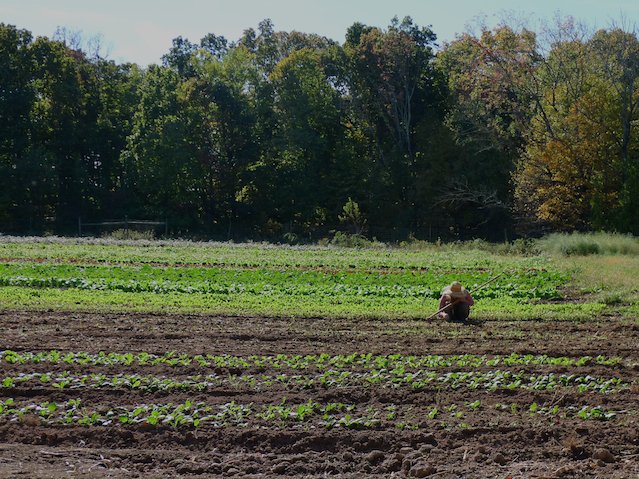
Notoriously slow to germinate and grow, baby carrots are difficult to cultivate because weeds easily outpace them. Here, Hannah is confirming their presence in their respective rows and will cultivate between rows.

October 16, 2016
Green Culture
By Derek McGeehan
Green Culture
By Derek McGeehan
Harvest #23 (Week A) should include kale, lettuce, potatoes, beets, carrots, collards, chard, arugula, spinach, mizuna, greens mix, leeks, chives, napa cabbage, escarole, endive, and savoy cabbage. Some items may be a choice and/or may not be available during all pick up times. U-pick should include dill, cilantro, parsley, and perennial herbs.
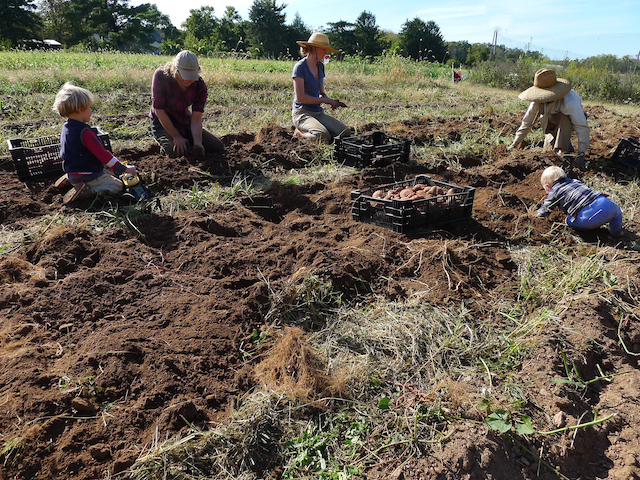
Sweet potatoes will grace the CSA share in a week or two after warm and humid curing to sweeten and improve storability. The entire ARF team helped retrieve these root-tubers after a light frost singed their sensitive leaves.

October 16, 2016
A Dry and Lovely Start to Autumn
By Derek McGeehan
A Dry and Lovely Start to Autumn
By Derek McGeehan
It's dry but it's tolerable this time of year with the low sun angle and diminished daylight and cooler temperatures. We've had enough precipitation to keep the crops happy but are curiously wondering when the cauliflower will head up. Typically we transition straight from the broccoli harvest into the cauliflower one, but this year, either due to bug pressure or some other factor, the cauliflower is a bit behind schedule. It could be thirsty. Greens are abundant right now as they should be with these cool days and nights. Infrequent light frosts are occurring as temperatures dip into the upper 30s, hopefully sweetening the flavor of many crops. White pines are beginning to turn some green needles to brown and will add a beautiful golden carpet to the landscape as they fall to the ground. Deciduous trees are also just starting to turn from green to gold and red. I feel like we only just departed summer and may feel like we have a brief return as temperatures climb to 80 degrees this week. That sounds okay; I'm not ready for the heating season just yet. Hope you are able to enjoy the great weather!
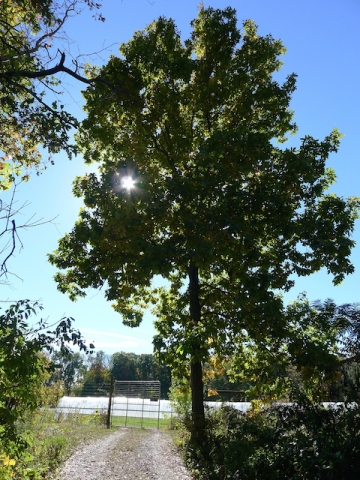
A majestic hickory on the way to Field 1.

October 16, 2016
Sign Up For 2016 Late Fall and 2017 Winter CSAs
By Derek McGeehan
Sign Up For 2016 Late Fall and 2017 Winter CSAs
By Derek McGeehan
Sign up now on the members' page to secure your spot in our 2016 Late Fall CSA and 2017 Winter CSA!
To run these seasons successfully we need to reach a critical mass of membership. As of now registration is only available to current 2016 Main Season members (i.e. you) and soon we'll open it up to the general public if we don't reach our goals (we want to reach these goals with you included).
We cap these seasons at about 25% of the Main Season membership size so please sign up to reserve your spot today!
Also, we're currently re-evaluating the best pick up day/time for Fall and Winter seasons, so please let us know if our proposed schedule does not work for you. The Late Fall CSA typically mimics one Main Season pick-up-days worth of members, about 100-120 shareholders, so we're okay with keeping a 1-8pm pick up window on Wednesdays. However, January and February being more difficult weather months and the fact that we're using this season experimentally and keeping membership numbers lower, we're probably going to move the Winter CSA pick up to Saturday daytime. Please give us some feedback if you wish!
2016 Late Fall CSA:
- 6 weeks of fresh and storage crops from weeks 11/13/16 through 12/18/16
- vegetables should include greens like arugula, spinach, mizuna, kale, collards, cabbage, napa cabbage, endive, escarole, lettuce, chard, and beet greens; roots like carrots, turnips, beets, radishes, potatoes, sweet potatoes, and kohlrabi; storage crops like onions and garlic; and freshly harvested alliums like chives, leeks, and scallions
- cold hardy vegetables grown outside with use of low hoops and row cover
- weekly full shares ($180) and biweekly half shares ($100) available
- share distribution on Wednesdays 1-8pm (except for Tuesday 11/22/16)
2017 Winter CSA:
- 8 weeks of fresh and storage crops from weeks 1/1/17 through 2/19/17
- vegetables should include greens like arugula, spinach, mizuna, kale, collards, cabbage, napa cabbage, lettuce mix, chard, and beet greens; roots like carrots, turnips, beets, radishes, potatoes, sweet potatoes, and kohlrabi; storage crops like onions and garlic; and freshly harvested alliums like chives, leeks, and scallions
- cold hardy vegetables grown inside of hoop house, high tunnel, and greenhouse
- weekly full shares ($240) and biweekly half shares ($130) available
- share distribution on Wednesdays 1-8pm (this may change to Saturday daytime)
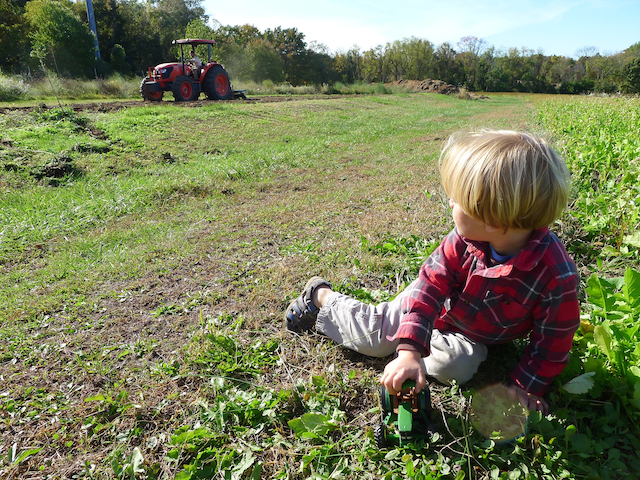
The final pass with the tractor and raised bed maker will make a nice home for winter greens like kale and arugula. Shortly after this shot was taken we moved the high tunnel one position downhill to protect the soon-to-be-sown greens for the winter. It protected the heirloom tomatoes over the summer.

October 9, 2016
Sign Up For 2016 Late Fall and 2017 Winter CSAs
By Derek McGeehan
Sign Up For 2016 Late Fall and 2017 Winter CSAs
By Derek McGeehan
Sign up now on the members' page to secure your spot in our 2016 Late Fall CSA and 2017 Winter CSA! For additional information please see the bulletin that was e-mailed to you this past week, log into the website and click the green "Join" buttons on the members' page, or look below.
2016 Late Fall CSA:
- 6 weeks of fresh and storage crops from weeks 11/13/16 through 12/18/16
- vegetables should include greens like arugula, spinach, mizuna, kale, collards, cabbage, napa cabbage, endive, escarole, lettuce, chard, and beet greens; roots like carrots, turnips, beets, radishes, potatoes, sweet potatoes, and kohlrabi; storage crops like onions and garlic; and freshly harvested alliums like chives, leeks, and scallions
- cold hardy vegetables grown outside with use of low hoops and row cover
- weekly full shares ($180) and biweekly half shares ($100) available
- share distribution on Wednesdays 1-8pm (except for Tuesday 11/22/16)
2017 Winter CSA:
- 8 weeks of fresh and storage crops from weeks 1/1/17 through 2/19/17
- vegetables should include greens like arugula, spinach, mizuna, kale, collards, cabbage, napa cabbage, lettuce mix, chard, and beet greens; roots like carrots, turnips, beets, radishes, potatoes, sweet potatoes, and kohlrabi; storage crops like onions and garlic; and freshly harvested alliums like chives, leeks, and scallions
- cold hardy vegetables grown inside of hoop house, high tunnel, and greenhouse
- weekly full shares ($240) and biweekly half shares ($130) available
- share distribution on Wednesdays 1-8pm
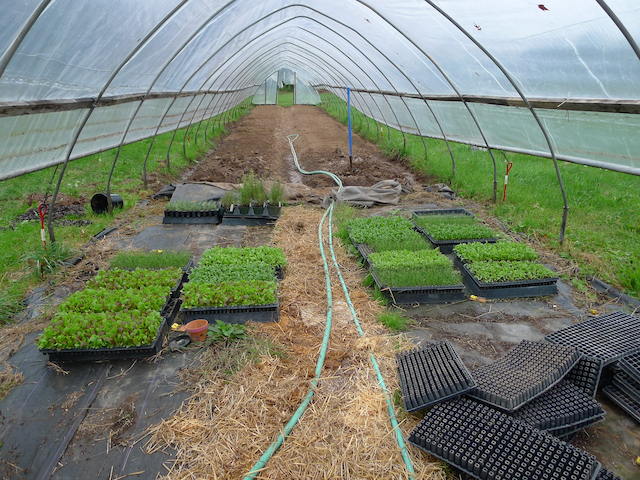
A site for Late Fall and Winter growing, the lettuce mix, spinach, scallions, and chard will probably end up calling the raised beds uphill home.

October 9, 2016
Turning Green
By Derek McGeehan
Turning Green
By Derek McGeehan
Harvest #22-Week B (out of 26 pick up weeks total) should include kale, lettuce, potatoes, chives, savoy cabbage, napa cabbage, chard, collards, mizuna, greens mix, leeks, spinach, arugula, broccoli, beets, turnips, and kohlrabi. Some items will be a choice and/or may not be available during all pick up times. U-pick should include dill, cilantro, parsley, and perennial herbs.

Amid a forest of kohlrabi and other greens, Hannah harvests loose arugula for our CSA-only distribution. Photo credit goes to Mary Liz.

October 9, 2016
Harvesting and Getting Ready for Winter
By Derek McGeehan
Harvesting and Getting Ready for Winter
By Derek McGeehan
Including this coming week there are five more weeks of pick up for the Main Season 26-week share. Directly after the conclusion of this season the 6-week Late Fall CSA begins. Planting and production has already commenced for fall and winter harvests; crops need to be in the ground and growing well before cold and dark descend upon our latitude. Days to maturity of crops will eventually double and perhaps triple when we're nestled in winter. Soon we'll employ hoops and row cover to keep outside crops blemish free from the adverse effects of a heavy frost. Eventually - think January and February - we'll only harvest fresh crops from the protection of the high tunnel, hoop house, and greenhouse. That's well down the road, but we have to plan for and prepare soil now, as well as sow and transplant. Our managed farm footprint slowly dwindles each week as we wrap up harvesting of certain crops and sow the hibernating soil with cover crops. Our mental map of the farm becomes easier to comprehend when we're only actively maintaining a small portion of what was managed at the growing peak of June, July, and August. Much of the farm fields still radiate a brilliant green with the cool weather suited cover crop mixes and will do so until we receive hard frosts and freezes with regularity. These cover crops are soaking up leftover nutrients from the soil as they gather sunlight and transform it into additional soil food for next year's cash crops. As they protect the soil over the winter they'll slowly degrade into next spring and release stored energy and the cycle will continue.
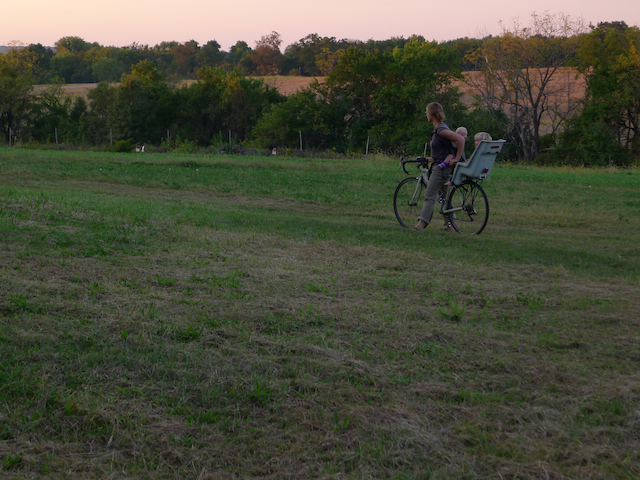
A fun favored method for meandering around the farm...sunset glows in the background.

October 9, 2016
Cabbage Soup
By Linda Dansbury
Cabbage Soup
By Linda Dansbury
Member Susan Gran sent me an email and a recipe for Cabbage Soup. Susan's note said that she didn't think she even liked cabbage until she ate this soup. It is a variation on Minestrone soup - and if you wanted to make it even heartier, you could surely add beans and/or pasta to this soup recipe.
Thanks to Susan for taking the time to send me the recipe. If you would like to share something with fellow members, please email me at lindadansbury@comcast.net and put Anchor Run in the subject line so that I can find it.

October 9, 2016
Fall cooking
By Linda Dansbury
Fall cooking
By Linda Dansbury
I found myself in the kitchen more this past week than I have in a long time. Is it a nesting instinct since the days are getting very short now and the nights and mornings have a distinctive chill? I don't know, but I had a lot of fun and the result is a lot of delicious food. Here is some of what I made this week. Please let me know what you made by emailing me at lindadansbury@comcast.net and please put Anchor Run in the subject line so I can find your message.
Leeks, onions, potatoes, thyme, chives - made the Potato Leek Soup recipe on this site. I like this one because it does not have cream so the flavor of the fresh ingredients really comes through.
Tomatoes, onions, basil, garlic - tomatoes this time of year don't keep very well and they aren't as tasty as they were even a month ago, but roasting them at a high temperature brings out their sweetness. Try the Roasted Tomato Soup with Croutons. It is delicious - and you don't even need the croutons.
Eggplant, garlic, parsley - used the last of my eggplants to make Baba Ganoush
Peppers - prepared a batch of Pepper Puree that a member sent me the recipe for last year. It is delicious and the uses for it are as limitless as your imagination. I plan to make another batch as soon as time allows.
Beet greens, kale, garlic - made an Asian style fish dinner in which I used the Wild For Salmon Pacific Black Cod with a Hoisin/Chili Paste"rub" on the fish to cook it and a sauce of Asian ingredients around it. Sauteed up the greens with ginger and garlic - they were all great with the Asian sauce.
Beets, onions - roasted a big batch of beets last Sunday and took half of them and made Pickled Beets.
Beets, salad greens - used the rest of the roasted beets in a beet and greens salad using a sherry vinegar/Dijon vinaigrette. Yum!

October 9, 2016
Fall abundance
By Linda Dansbury
Fall abundance
By Linda Dansbury
Two things really hit me as I sat to write this morning. Each week, Derek emails me with the expected harvest for the week. He titles the email with what pick up week it is. I was startled by the fact that it is already week 22 - it seems like such a short time ago that it was week 1! The other thing that jumped out at me is the incredible variety of veggies that are available to us at this time of year. We are fortunate to live in a climate that supports the many diverse crops it does and even luckier that we have amazing farmers that care as much a D&D and their farm staff about growing such nourishing food for us!
For ideas on how to use this variety, search this site - I still do and even if I don't select a specific recipe, I get ideas for using the veggies.
A couple notes about cabbage. First, it keeps very well when stored in a plastic bag or container in the fridge meaning that you don't need to use it within the first couple of days of picking up your share.
Cabbage is of course delicious in slaws - my family and friends love my Asian Slaw recipe. Cabbage is also delicious when cooked - check out the site, but I used cabbage in a way that doesn't require a recipe: Chop/slice it as you would for cole slaw. Melt a little butter and olive oil together and when heated, add the cabbage and saute it over med heat until it is tender and slightly browned - keep a fairly close watch, as it can burn easily. Simply salt and pepper to taste and sprinkle with fresh herb(s) such as chives, parsley and/or thyme. When cooked like this it takes on an almost sweet, nutty taste. It goes really well with pork and chicken.
We are back to receiving a lot of greens - embrace it and add them to many of the dishes that you cook - don't worry if the recipe doesn't call for them: soups, stews, chili. Saute a single green or combo with garlic, onion, a hot pepper. Add other things to suit your family's taste. Keep the tops to turnips, beets, radishes to add to all these dishes - I was amazed last night to see that I have really kept up with using my greens, even though for the most part I am only cooking for the 2 of us.
Enjoy the Abundance!

Well now who can resist a colorful photograph featuring a monarch butterfly snacking on New England aster nectar? Thanks to Mary Liz for the photo.

October 2, 2016
Potluck Meal and Celebration - Sat. 10/8 5pm
Potluck Meal and Celebration - Sat. 10/8 5pm
Join us in celebration of the delightful arrival of autumn with a final potluck of the 2016 season on Saturday October 8th at 5pm. Bring a dish to share to feed around 6 adults plus your own place settings and beverages. We'll eat under the pavilion, enjoy the night sky and a small fire.

October 2, 2016
Saying Goodbye to Summer Veggies
By Derek McGeehan
Saying Goodbye to Summer Veggies
By Derek McGeehan
Harvest #21 (Week A) should include garlic, beets, kale, lettuce, arugula, spinach, mizuna, greens mix, chard, potatoes, sweet peppers, hot peppers, tomatoes, green tomatoes, cabbage, escarole, and broccoli. Some items will be a choice and may not be available during all pick up times. U-pick should include the last of the cherry tomatoes, plus dill, cilantro, parsley, and other herbs.
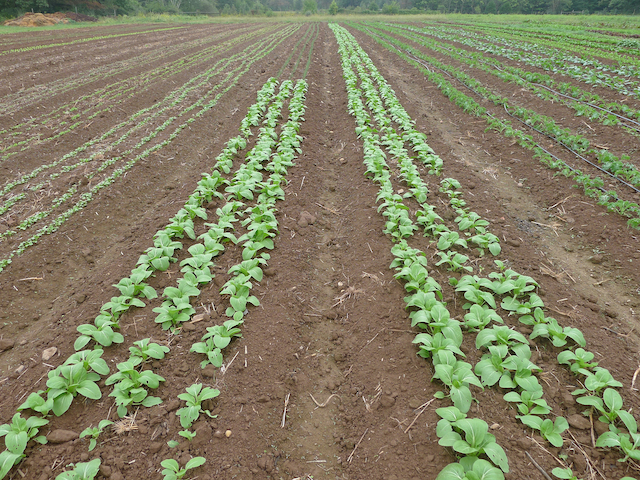
Food to look forward to! Shown here are late season direct seeded carrots, radishes, arugula, kale, and mustard greens mix as well as transplanted bok choy, scallions, kale, and collards.

October 2, 2016
2016 Late Fall CSA; 2017 Winter CSA
2016 Late Fall CSA; 2017 Winter CSA
Sign up now on the members' page to secure your spot in our 2016 Late Fall CSA and 2017 Winter CSA! For additional information please see the bulletin that was e-mailed to you this past week, log into the website and click the green "Join" buttons on the members' page, or look below.
2016 Late Fall CSA:
- 6 weeks of fresh and storage crops from weeks 11/13/16 through 12/18/16
- vegetables should include greens like arugula, spinach, mizuna, kale, collards, cabbage, napa cabbage, endive, escarole, lettuce, chard, and beet greens; roots like carrots, turnips, beets, radishes, potatoes, sweet potatoes, and kohlrabi; as well as storage crops like onions, garlic, and butternut; and freshly harvested alliums like chives, leeks, and scallions
- cold hardy vegetables grown outside with use of low hoops and row cover
- weekly full shares ($180) and biweekly half shares ($100) available
- share distribution on Wednesdays 1-8pm (except for Tuesday 11/22/16)
2017 Winter CSA:
- 8 weeks of fresh and storage crops from weeks 1/1/17 through 2/19/17
- vegetables should include greens like arugula, spinach, mizuna, kale, collards, cabbage, napa cabbage, lettuce mix, chard, and beet greens; roots like carrots, turnips, beets, radishes, potatoes, sweet potatoes, and kohlrabi; as well as storage crops like onions, garlic, and butternut; and freshly harvested alliums like chives, leeks, and scallions
- cold hardy vegetables grown inside of hoop house, high tunnel, and greenhouse
- weekly full shares ($240) and biweekly half shares ($130) available
- share distribution on Wednesdays 1-8pm
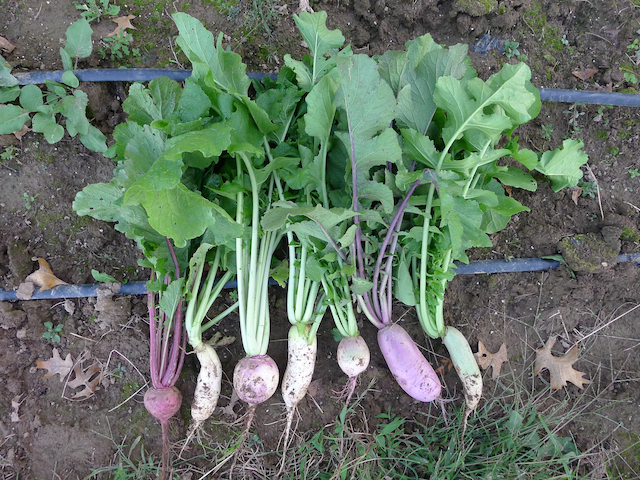
A variety of fall and winter roots are looking healthy above and below ground. Traditionally we remove their tops for distribution and storage. Left to right: scarlet queen red stem, des vertus marteau, and purple top turnips; alpine daikon, watermelon, bravo daikon, and green meat radishes.

October 2, 2016
Finally a Fall Feeling
By Derek McGeehan
Finally a Fall Feeling
By Derek McGeehan
We're safely into October and we haven't seen the sun in half a week, received a nice light soaking rain, and are beginning to say goodbye to the last of the summer vegetable staples like tomatoes and peppers. We're transitioning away from sowing warm season annual cover crop mixes of buckwheat and daikon radish on finished fields and for a brief period will hope to establish oats and crimson clover before switching completely to winter rye and hairy vetch. Cover crops we sow after cash crops will largely determine what we can plant where next spring, summer, and fall. Buckwheat, daikon, and oats will winter kill and slowly desiccate and decompose over the cold months and should leave the soil in an almost perfect state of planting condition next season. Clover, rye, and vetch will go dormant over the winter, regrow in the spring, and will be turned into the soil after flowering in May. The clover and vetch will also fix nitrogen in the soil. Rye produces so much organic matter that we'll either fallow those fields or plant fall crops, giving the soil and organic matter time to process into a workable condition. Also affecting what goes where in the spring will be what was where the past 3-5 years. Crop rotation is an essential part of organic farming, crop and soil health. With good record keeping and ample land for proper rotation and resting, the pieces of the puzzle become easier to fit into place.
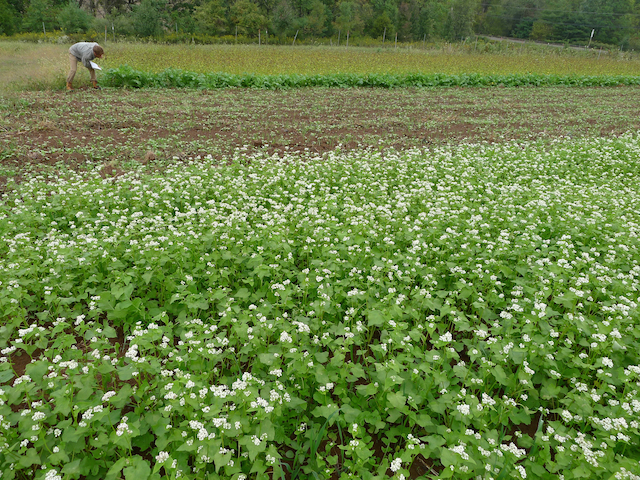
Three stages of growth of buckwheat and daikon radish cover crops are seen here. I'm looking at a 3-inch thick and growing daikon taproot in a patch where the buckwheat has finished flowering and is beginning to senesce. Buckwheat grows quickly to suppress weeds, attracts pollinators, then dies back to allow the daikon understory to take over.

October 2, 2016
A Great Use for Holy Basil
By Linda Dansbury
A Great Use for Holy Basil
By Linda Dansbury
Fellow member, Vallada Nikolayev sent me her recipe for a dish called Holy Basil Pesto with Ground Turkey. The overall process and some of the ingredients are very similar to a Thai curry - only simpler to make. This will be an easy, fast and healthy week night dinner. Thank you Vallada for taking the time to send this interesting recipe.
Please send your ideas to me at lindadansbury@comcast.net

October 2, 2016
Fall Deliciousness
By Linda Dansbury
Fall Deliciousness
By Linda Dansbury
I did start to cook more this past week using both summer crops and newer fall items. Here is a sample of what I prepared:
Peppers, garlic - made the Pepper Puree recipe that is on this site. I made 2 batches - one of which I added a hot pepper and the other without. I made it with hot peppers last year and it made a wonderful spread for sandwiches. This year I decided I wanted some that is mild also. It freezes great, but I did run out quickly because it is so delicious.
Tomatoes, onion, garlic, okra - I made the Charred Okra and Tomato recipe that Derek's family had sent in. Rather than a side dish, I made it into a meal by adding shrimp and making rice. It was really tasty.
Tomatoes, onions, carrots, garlic, parsley, butternut squash - I finally made the Fall Stew that Tina Nightlinger sent in. We loved it! This recipe has a north African taste profile and is delicious and different from anything I have made. It is filling as is, and would also be great over some brown rice or other whole grain.
Today I plan to roast beets so I can make salads and pickle some beets too.
Send me how you enjoy your harvest at lindadansbury@comcast.net and please put Anchor Run in the subject line so I can find your email.
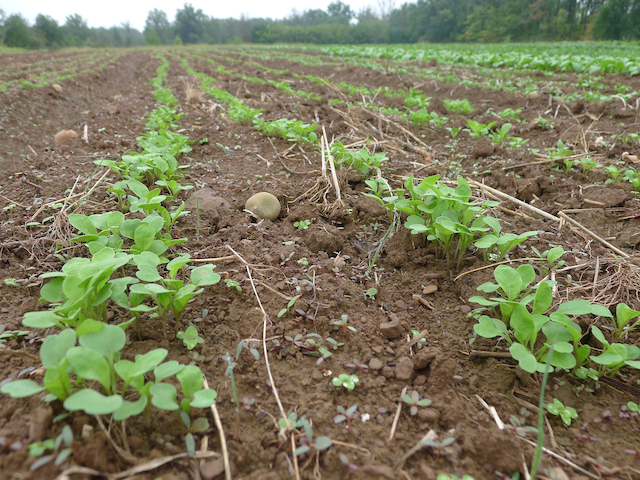
This direct seeded arugula appreciated the rainfall and it appears that the weed seeds did also. Whenever the sun comes out again it will be time to cultivate.

POSTS BY TYPE
POSTS BY MONTH

